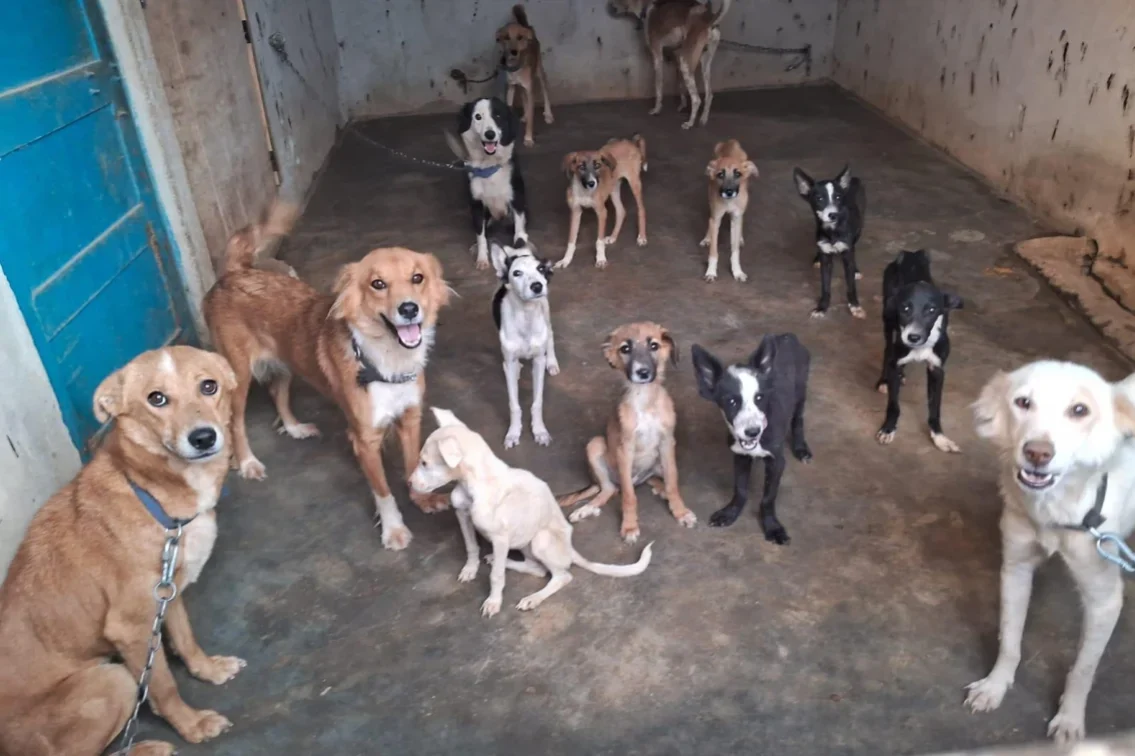We love foreign breeds. However, there are so many great Indian breeds to get to know.
In India, especially in the cities, you might often see people taking a Husky, a Labrador Retriever, or a St. Bernard for walks. India has a tropical climate, so why do we promote and encourage the breeding of dogs that were meant for colder climates?
India is full of its own rich dog heritage
There are so many dog breeds within India- and stray dogs are descendants of these ancient breeds. Let’s take a look at some of them. It’s important to understand that animals from a particular region are always going to be healthier in their natural habitat.
Many people ask: “What is the breed of Indian street dogs?” The fact is, there are so many different breeds in India to study and learn about.
Meet (Badi) Shilpi – She was rescued in Delhi with tick-fever and brought to our Dog Shelter. But now towers over most of the VOSD dogs at a healthy 70 kilos.
Popular Indian dog breeds
Rajapalayam

Tipu Sultan first introduced this breed to South India during his reign. The Rajapalayam is a sighthound and was considered a worthy companion to the aristocratic classes. The name comes from the town of Rajapalayam, in the Virudhunagar district of Tamil Nadu. They are good guard dogs, and have been used for hunting.
Himalayan Sheep Dog

These are more commonly known as the Gaddi Kutta- and are raised by Gaddis in Himachal Pradesh and Uttarakhand. These dogs come in many shapes and sizes, but characteristically have more fur than other Indian breeds because of their colder habitat. Gaddi Kuttas are used by the shepherds to look after livestock and you can see them all over the mountain region.
Rampur Greyhound

The Rampur Greyhound is a type of hound descended from the Afghan Hound. They are short-haired with a powerful build, after being interbred with Greyhounds to improve their strength. The Rampur Greyhound is found in North India. The number of these dogs is dwindling, but they were also favoured by the aristocracy in West Bengal and the regions around Delhi.
Combai/Kombai

You would have definitely seen this dog in South India at some point. These dogs are usually coarse-haired and brown. Combais make effective guard dogs and are suitably aggressive for the job. This breed evolved naturally and is, therefore, less prone to diseases and health ailments. They make great family dogs as well.
Chippiparai

Another beautiful hound from the Madurai region of Tamil Nadu, the Chippiparai was used for hunting purposes. There are a few of them left and are endemic to Periyar Lake in Tamil Nadu. The Chippiparai has coarse, short fur, and are of medium build. They are tough, and rarely face health disorders.
Tazi/Taji

Another hunting dog, the Tazi is a beautiful, slightly furrier dog. They are extremely rare today. They resemble the Russian Tazi, but with less fur. Tazis are playful and friendly.
Indian Pariah Dog

A true Desi Kutta! You might confuse them with many other stray dogs, but the Indian Pariah Dog has its origins dating back to around 4000 years. They are from the subcontinent and you can spot them in Bangladesh too. Desi Kuttas are friendly, lovable, easy to train, and adorable. They are of medium build.
Mudhol Hound

These hounds look a bit like the Rajapalayam. They are very popular in India- especially in villages in Karnataka. You might also know them as Caravan Hounds. They are good as hunters and guard dogs. While loyal, Mudhol Hounds are generally a one-owner dog and can be hostile to strangers (which make them perfect for guarding a home).
Tangkhul Hui

Time to give some love to a breed from the North East. The Tangkhul Hui is a beautiful and fascinating dog found in Manipur. People consider the Tangkhul Hui endangered, and are trying to work together to revive the breed. Because of its furry and dark visage, it vaguely resembles the Asiatic black bear.
The benefits of adopting an Indian dog breed
The benefits of adopting an Indian dog breed
They are low maintenance
Indian dog breeds are low maintenance and easy to handle at home. They aren’t overly large dogs (except maybe the Rajapalayam), and they usually have short coats (unless they’re Gaddi kuttas!), so it’s easy to keep them clean AND also spot injuries or growths fast.
They make for great guard dogs
Indian dogs are used to the streets – especially Indian stray dogs. Sometimes, stray dog packs even keep neighbourhoods safe if they suspect foul play! You will have a great guard dog in an Indian dog.
They offer companionship and loyalty
Like all domesticated dog breeds, Indian breeds are friendly, vivacious, and love to hang out with people. You will never regret having one!
They are street smart with survival instinct
As we mentioned earlier, an Indian street dog is used to roughing it out. They are tough dogs and are able to adapt to public spaces very fast.
They have healthy immune systems
A diverse and rich genetic heritage is known to help dogs remain healthier, fitter, and avoid the problems of inbreeding.
Why are Indian dog breeds becoming more popular?
An Indian stray dog, or an Indian Pariah dog, is easier to adopt, less expensive, and less maintenance than a purebred. People often spend lakhs of rupees on purebreds like Golden Retrievers, Boxers, Huskies and so on. There are also the costs that come up when raising a foreign, or non-endemic breed. Purebred dogs are more likely to have a host of health issues related to their inbreeding, their non-endemic habitat, and neglect from breeders and pet stores.
While there is a lot of paperwork involved in adopting a stray dog, the benefits of adopting (for both you and the dog) cannot be stressed enough. The act of adoption is great for the psyche, and for one’s emotional well being. Adopted dogs usually come trained, and are socialised. If you are a new pet owner, it might make much more sense to go down this route as well.
The unfortunate reality in India is that there is an abundance of illegal, unregistered pet “shops” that sell and deal purebred puppies and dogs. These places often neglect the dogs, provide them with bad quality food, and keep them caged and in confined spaces for long periods of time. Puppy mills often abandon female dogs once they’ve given birth to enough puppy litters. This treatment is unethical, and it makes no sense to encourage it when there are so many millions of dogs that are already looking for homes.
Frequently Asked Questions (FAQ)
1. What dogs are native to India?
Some of the most common Indian dog breeds are as follows:
- Indian Pariah: These are more commonly found in your neighborhood and have a descent of more than 4000 years. They have a thin coat, are medium-sized, and very docile in nature.
- Tazi: This is one of the most beautiful, large Indian dog breeds that are rarely found today. They have quite the fur and are typically used for hunting.
- Rajapalayam: This is a type of sighthound which was first introduced during Tipu Sultan’s reign. It is native to Tamil Nadu and is a hound dog.
- Rampur Greyhound: This is a type of Greyhound that is mostly found in New Delhi and West Bengal. It has moderate fur and is quite strong in nature.
- Himalayan Sheep Dog: Native to the hilly areas of the Himalayas, this breed has more fur than other Indian dog breeds and is used as a guard dog for cattle rearing.
- Kombai: This dog breed is a typical guard dog, native to Southern India, and holds the aggression to commit to its job.
- Tangkhul Hoi: This dog breed is more commonly found in Manipur, and has a thick, black fur coat. It is now an endangered breed.
- Mudhol Hound: These are also known as Caravan hounds and are great for guarding and hunting.
2. How many Indian dog breeds are there?
Some of the common Indian dog breeds include the most popular Indian Pariah, native South Indian breeds that include the Rajapalayam, Kombai, and the Chippiparai, hill dogs including the Tangkhul Hoi and the Himalayan Sheep Dogs and some great breeds used for hunting or guarding that include the Mudhol Hound, Rampur Greyhound, and Tazi.
3. Which dog is best to raise as a pet in Indian conditions?
Most Indian homes prefer a small to a moderate-sized dog. While all dog breeds can adjust to family life, there are several types of Indian street dogs that perfectly fit in a family of 3, 4, members, or more. These dogs have lesser chances of having excess health issues, are very friendly and easy to handle, and also work smartly to protect a family, in case of any urgency.
If you are looking for a moderate-sized dog, you can adopt an Indian Pariah which is the most common street dog breed available. If you live in Southern Indian, the Kombai or Rajapalayam can be great choices. The northern regions of the country can enjoy living with the quirks of a Rampur Greyhound which is another strong and friendly breed, with low maintenance.
4. How can I identify my Indian dog breed?
An Indian dog is usually interbred in comparison to purebred dogs like the Rottweiler, Husky, or Golden Retriever. These dogs have less fur, are easy to maintain, and are super friendly. Not sure which breed of Indian street dog you possess? You can visit your veterinarian who will be able to distinguish the breed and lineage.
In any case, all Indian stray dogs are quite healthy and low maintenance with most having an excellent temperament making them great pets.
5. Are any dogs banned in India?
There is no ban on any particular breed of dogs in India. However, some dogs should not be kept in the Indian climate especially purebred dogs like German Shepherds, Rottweilers, and Huskies who are used to a cooler temperature annually. They have a very high maintenance coat that is prone to shedding owing to their thick fur. These dogs are also prone to catch diseases in our weather condition making them suffer and die much earlier than their normal life span.
Since India is in a tropical climate, purebred dogs like Huskies find it difficult to manage, are prone to constant sweating and panting, shedding of fur, and fever due to the excess heat. So, adopting Indian mixed breed dogs is a better idea for anyone who loves dogs and pets in general.





